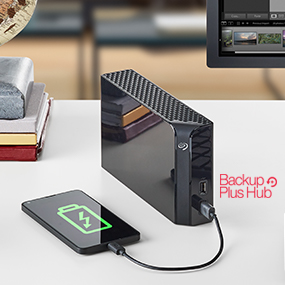Backup Plus 1tb Thunderbolt Portable External Hard Drive For Mac

I feel old saying this, but having used computers since before external hard drives existed, I can say with certainty that buying a hard drive is easier today than it’s ever been before. For traditional drives, prices are low, options are numerous, and capacities are so high that your only choices are “enough space,” “more than enough space,” and “way more than enough space.” I could point you towards a and end this article without another paragraph. Since Apple doesn’t even sell a Mac with that much disk space, you could back up five (or more) computers to that drive without running out of room.
Lg ced 8120b drivers for mac. Oct 25, 2012 This is a high end, high capacity, and relatively high speed external hard drive for Macs. The most interesting feature is that the hard disk can be removed and swapped out with other SATA drives.
Or you could store a decade worth of digital photos alongside a giant media library. But buying an external hard drive isn’t necessarily that simple. There are a bunch of factors worth considering before making a purchase, including everything from reliability to portability, design, capacity, speed, and connectivity. Some hard drives are really cheap but have a higher chance of failing after a year or two of heavy use. So in this How-To, I’m going to discuss the big issues you need to consider, and guide you towards the best external hard drive for your needs Quick Overview Most hard drives are guaranteed to work for one to two years no matter what you do with them, ranging from occasional backups to continuous video streaming. They’ll generally last much longer if you don’t use them every day. However — and this is really important — if you keep a typical drive mechanism running 24 hours each day for two years, it’s going to burn out. Hard drive longevity used to be measured with an estimate of “Mean Time Before Failure” (MTBF).
Each year has 61,320 hours, so a drive with a MTBF of 300,000 hours would promise to last 4.9 years if actively used 24 hours each day. Desktop drives typically promised higher MTBFs than laptop drives, but there were exceptions. Unfortunately, MTBF numbers were only predictions — and often inaccurately high. Robot framework selenium. Consumers complained. So drive makers switched to a different but even less useful metric: Annualized Failure Rate (AFR), which estimates the percentage of total drives made that will fail in a year due to manufacturing defects. All an AFR of “0.73%” suggests is that 7,300 of 1,000,000 drives will likely develop problems in year one due to defects rather than abuse. That low percentage may seem reassuring, but it obscures the reality that heavy drive use increases failures over time, and some drives are much better-suited to heavy use than others.
My advice: purchase your drive with a specific purpose in mind. If you’re backing up precious photos, home videos, or important files, buy a name brand, desktop-sized hard drive from a company with a track record of reliability, and pay a little more for it. It doesn’t really matter how the drive looks, just that it will work for a long time. But if you’re just using a drive to store apps, games, or iTunes movies that you can easily re-download at any time, or only intermittently turn a drive on for backups, you can feel comfortable going with something cheaper, more portable, or fancier-looking. Capacity + Pricing It’s easy to pick the right hard drive capacity these days: most external drives now offer at least as much space as a standard Mac (1TB) — and there are — and you can get an. Most people will find that that 4TB is more than enough to hold years of accumulated photos, media files, and data, but there’s no wrong answer to the capacity question: it’s mostly a matter of personal preference right now.